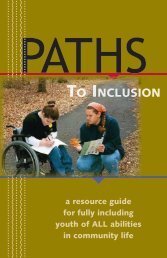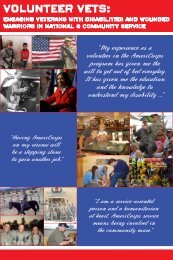Active Citizens 101 - National Service Inclusion Project
Active Citizens 101 - National Service Inclusion Project
Active Citizens 101 - National Service Inclusion Project
Create successful ePaper yourself
Turn your PDF publications into a flip-book with our unique Google optimized e-Paper software.
Training Methods, cont.<br />
Your role, however, is not passive. In a directed<br />
discussion, all participants should<br />
be treated as equal partners. Encourage<br />
everyone to participate. Be sure members<br />
listen to one another. Don’t allow the conversation<br />
to stray off the topic.<br />
Make a list of ground rules for all discussions<br />
and ask participants to agree to<br />
them prior to the first discussion.<br />
Here are some suggested<br />
ground rules for discussions:<br />
• State your ideas and opinions<br />
clearly.<br />
• Support your statements with<br />
facts or logical arguments.<br />
• Define the terms you use.<br />
• Keep an open mind and listen to one<br />
another.<br />
• Respect the opinions of others.<br />
• Work together to answer the questions<br />
posed.<br />
Small Groups<br />
By working in small groups of two to five<br />
members, people get the opportunity to<br />
communicate, cooperate, persuade, bargain,<br />
and compromise. They learn that an<br />
effective technique for problem solving<br />
may come through the efforts of groups<br />
rather than individuals. In small groups, it<br />
is easier for everyone to make a contribution.<br />
Here are a few tips to make small<br />
groups work:<br />
• Make sure people understand the activity<br />
before they begin.<br />
• Give each group member a task.<br />
• Monitor progress by circulating among the<br />
groups.<br />
• Encourage members to participate inside the<br />
group.<br />
Handling Controversy<br />
Disagreement is a real—indeed<br />
necessary—part of dealing with<br />
community issues. Controversy<br />
cannot, and should not, be<br />
avoided. When properly handled,<br />
disagreements can bring<br />
information and understanding<br />
to a discussion. When controversy<br />
arises in discussion, clarify the disagreement.<br />
As facilitator, your role should<br />
remain neutral. Identify the issue under<br />
dispute. Point out areas of conflict and<br />
agreement, and look for assumptions that<br />
give rise to the controversy. When conflict<br />
becomes apparent, ask participants<br />
to follow these ground rules:<br />
• Argue ideas, not personalities.<br />
• Use “I” statements to express point of<br />
view.<br />
• Use active listening skills to carefully represent<br />
the opposite viewpoint fairly and<br />
accurately.<br />
• Concentrate arguments on facts and<br />
information.<br />
If necessary, bring in one or more<br />
resource persons who can provide a balanced<br />
perspective on the issue at hand.<br />
DRAFT<br />
5






